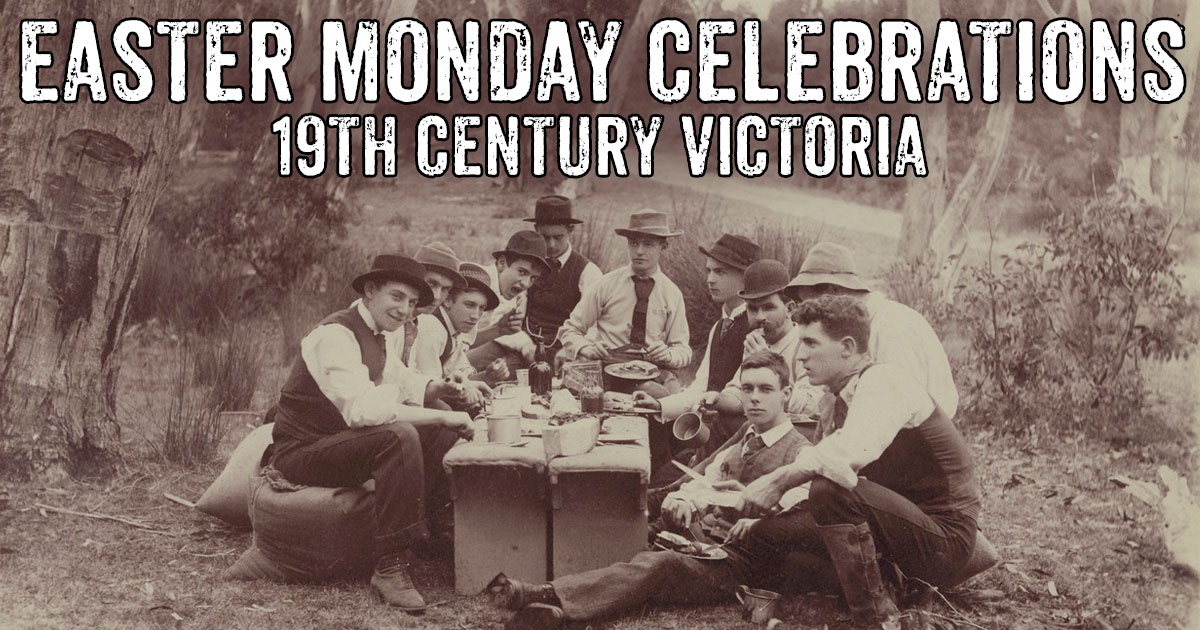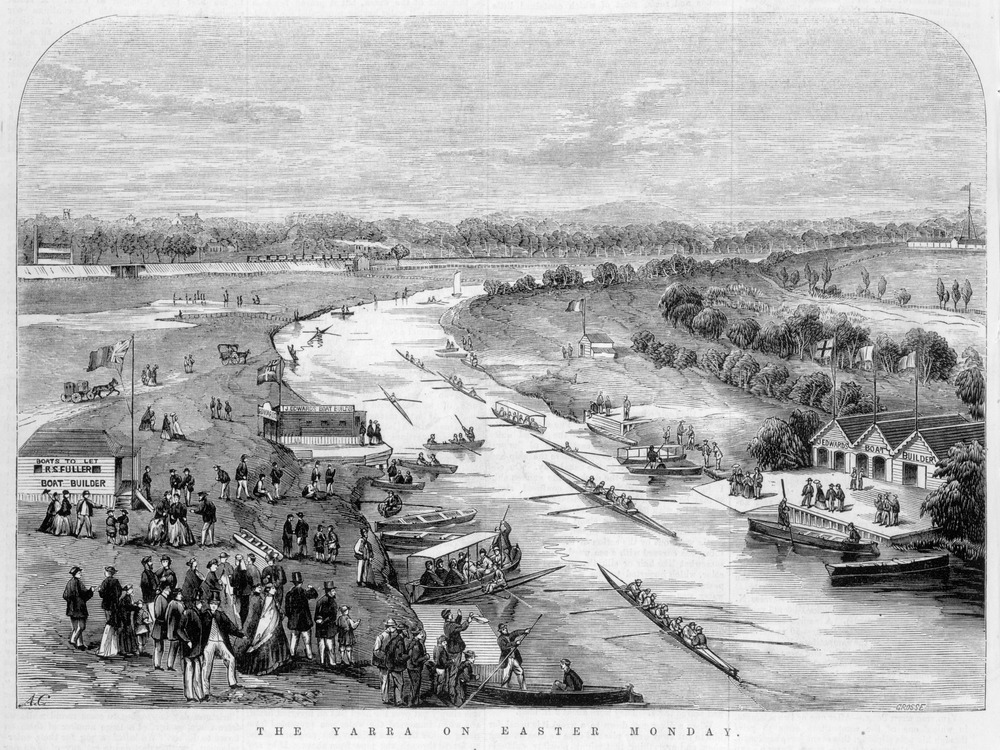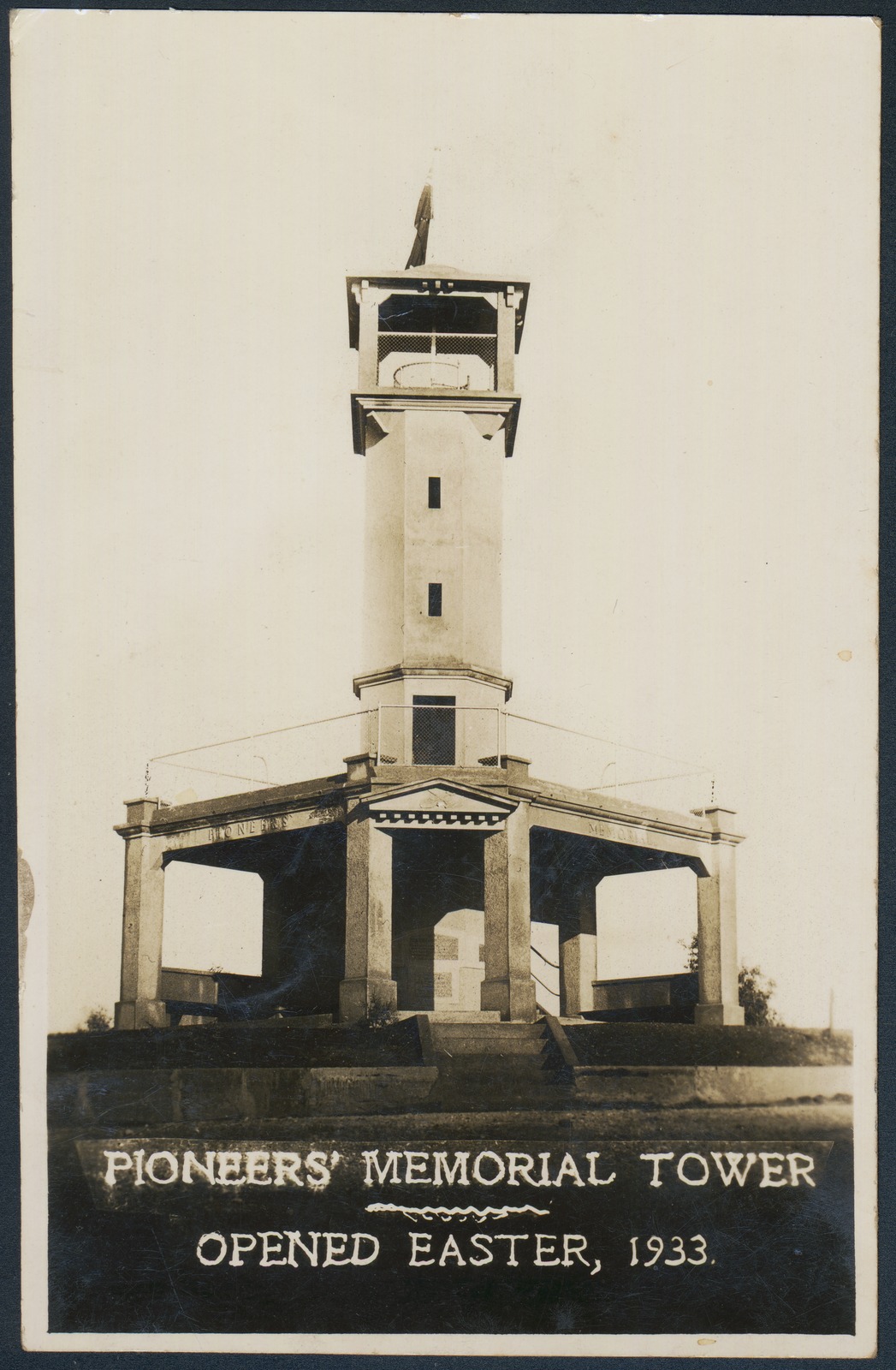
Whittlesea Camp, Easter Dinner, 1894. Source: State Library Victoria.
Easter during the 19th century in Victoria was a time for festivity and leisure, with Easter Monday being the main day of celebration. Picnics, parades, sports, dancing, and trips to the beach or country were enjoyed on the holiday. Newspapers described the events of the day in fond recollection, articles which today offer us many insights into the holiday celebrations of the time. The following newspaper articles from the 1860s describe some of the typical joyous Easter Monday festivities across Victoria.
Melbourne's 1866 Easter festivities were described in The Australian News for Home Readers, Wednesday 15th April 1866:
Melbourne never seemed more thoroughly imbued with tho festival spirit than on Monday. Of course a large number commenced "taking their holiday" on Good Friday, but it is only on Easter Monday that the people can be seen thoroughly enjoying themselves en masse. The weather was not of that tropical fervor and brilliancy which we usually associate with Australian festivals ; and occasionally, in the afternoon, the clouds assumed a menacing aspect; but there was abundant sunshine to gladden the hearts of the pleasure seekers, even if they did not enjoy that 'sunshine of the soul' which is superior to external influences ; and upon the whole, the coolness of the atmosphere was peculiarly favorable to the chief pastimes of the day. For a considerable portion of the afternoon the city seemed forlorn and desolate, as every business establishment was closed, except those whose business is pleasure ; and, judging from appearances, they did an exceedingly pleasant stroke indeed. Among so many attractive sources of amusement, it seemed no easy task to select the most enjoyable, and the most suitable to domestic ways and means.
Sunbury was, no doubt, the most ambitious scheme of all; and one might almost recognise those who meditated witnessing the great military pageant, as they hastened somewhat pretentiously towards the railway. Among these there were comparatively few family groups, although, as was natural, there was a tolerably fair representation of young Australians, eager to witness the mimic warfare in which they hope soon to take a prominent part.
Collingwood almost transcended its former efforts in the 'infinite variety' of fun and frolic provided for the occasion- from Highland dancing to running in sacks ; from a Richardsonian 'revival' to the election of the biggest and best baby in the "purloins." But, alas! for those who went, hoping to bask in the smiles of the Collingwood Queen of Beauty. Never was verdant spooneydom more deliciously sold. Although the donors saw only a few funny photographs, instead of blushing young maidens, they seemed considerably more amused than disappointed. There could scarcely have been less than ten thousand spectators on the ground.
The Grand National Gathering at the Zoological Gardens also attracted an immense number of spectators, who evidently enjoyed the goods the gods had provided, both externally and internally; and as for those who attended the Catholic pic-nic in the Botanic Reserve, they went in for the "gay and festive" with such thorough abandon, that it will require some effort to restore them to mere ordinary commonplace existence.
But altogether apart from these demonstrative recreations, there were numerous groups scattered here and there, wherever the picturesque beauty of the spot invited a bivouac. In Studley-park, on the more secluded banks of the Yarra, and the seashore at Brighton - in short, wherever the eye could rest upon pleasant scenery - there were clusters of this kind - not a few suggestive of tender and romantic conceits, and all evidently bent upon rendering this Easter Monday a joyous memory for the whole year. Order, decorum, and sobriety reigned every where, as an indispensable element of the merry making of a civilised and self-respecting community.
Source: www.trove.nla.gov.au

The Yarra on Easter Monday, Frederick Grosse, engraver, 1867. Source: State Library Victoria.
The 1867 Easter festivities both in Melbourne and towns such as Sandhurst, Echuca and Geelong were described in The Age, Tuesday 23rd April 1867:
Easter Monday
Everyone made holiday yesterday. The weather was as genial as a sunny morn in spring, and the people turned out in tens of thousands for enjoyment. There were excursions by water and rail. The river was clear and bright to look upon, and away from the city there was experienced an exhilarating breeze, which rendered open air amusements delightful. All business was suspended. Like bees swarming from the hive, groups of families, with Paterfamilias acting as cicerone, directed their steps as their inclination was bent.
The attraction of a sham-fight, with the paraphernalia and accessories of war, but shorn of its horrors, drew thousands to the Spencer-street railway station, where the authorities, in anticipation o a rush, had made the necessary preparations for the despatch of visitors to the Volunteer Encampment. At an early hour, the 14th Regiment, some 300 strong, marched through the city to the strains of martial music, to take part in the mimic strife at Sunbury. This gave a fillip to the projected display, and the trains which subsequently left the railway terminal were crowded with passengers.
As each succeeding year adds to the efficiency of our Volunteers, the public exhibit greater interest in their annual celebration. The volunteers manifest greater enthusiasm as they become habituated to discipline, and acquire perfectness in their manoeuvres, and are imbued with a spirit of emulation which a friendly combat with the regular troops is calculated to enhance. Parades, encampments and sham fights may be only "playing at soldiers", but it is by such means that in times of peace men are fitted to take part in actual strife. No wonder that the Sunbury encampment was the great attraction. The railway station was for several hours thronged with persons desirous of proceeding to that locale, and the precaution that was taken to provide additional ticket offices to avoid the rush and jostling inseparable from large crowds eager to proceed to one destination, prevented much of the unseemly bustle and squabbling experienced on other stations during a holiday. The trains left the terminus at intervals during the forenoon, conveying to and from about 10,000 persons. The trains from the interior also contributed their quota of pleasure seekers to the encampment.
Not a few went down as far as the Werribee, to participate in or witness the angling match on the river, for which a more delightful day could not have been chosen. There were many metropolitans who proceeded as far as Geelong, and spent the day in lionising, or meandering along the banks of its pretty bay.
Report says that the Bonifaces in some of the country towns on the Murray River line of railway - Sandhurst and Echuca to wit - experienced a fair share of holiday favors, and had reason to regret that they did not possess more ample accommodation for visitors.
Those who studied economy in their holiday arrangements availed themselves of a trip along the suburban line of railway either to St. Kilda or Brighton, of these two marine resorts, the latter was this year the most popular. The beach was literally alive with pleasure parties who gave vent to their enjoyment according to their tastes and dispositions. The Esplanade at St. Kilda had also its votaries, but they were less numerous.
The returns from the department show that the number of passengers who travelled along the Melbourne and Hobson's Bay United Railway line, yesterday were very great. To Sandridge and Williamstown, 4887. St Kilda and Emerald Hill, 1136. Windsor etc, 2176. Do, do, 1777. Brighton, 2692. Hawthorn, 1058. Making a total of 13,726 persons.
Yesterday was also chosen as the anniversary of the Eight Hours Movement. The procession through the city was fully equal to that of previous years. Their banners flaunted just as gaily in the breeze as they were wont years ago, then the association was but in its infancy. But the principle for which its members contended has become popularised, and this annual ceremonial is now looked forward to more as a reunion of the members of their families, who assembe together in some chosen spot - this year the North Botanical Gardens, where mirth and joviality reigned supreme.
The Roman Catholic Picnic, on the Botanical Reserve, the Athletic Sports of the Melbourne Cricket Ground, and the Collingwood Sports, were each centres of attraction for thousands, and respectively furnished their quota of gratification to those for whom the committees of management made provision.
Source: www.trove.nla.gov.au.

Maryborough Pioneers' Memorial Tower, opened Easter 1933. Source: State Library Victoria.
Maryborough's iconic Bristol Hill Pioneers' Memorial Tower was opened on Easter Sunday, 1933. A souvenir booklet was released for the tower's opening which provides lots of fascinating details about Maryborough's 19th century pioneers and their way of life. The following paragraph was included:
Our pioneers were the gold diggers of the fifties - the adventurous spirits of Europe. Certainly the squatters were in Victoria before them, but they were few. The gold diggers were the real founders of our nation; they were the founders of Maryborough; and on a site where they labored, not far from where gold was first discovered, this memorial stands. They were men of grit and determination, and we are their descendants. Some succeeded in their quest and some failed, but Victoria emerged the solid State that it has remained ever since. The grit and enterprise of these hardy men and women have been the mainstay of Australia ever since.
Easter festivities around Maryborough in 1861 were described in the Maryborough and Dunolly Advertiser, Wednesday 3rd April 1861:
Easter Monday
Monday last, being Easter Monday was a great day for the children of the various schools in Maryborough and the vicinity, pic-nics being the order of the day. About ten o'clock in the morning High-street was alive with boys and girls all agog for a day's pleasure, and preparing themselves for it by shouting and rushing about in a way that threatened to exhaust their strength before they could make a start for the ground where all the anticipated delights were to be experienced.
Conveyances of different kinds soon made their appearance, and the young pleasure seekers were quickly stored away, and driven off to the spots selected: The Church of England scholars repairing to Nuttall's paddock, near Carisbrook, where they were to be met by the Carisbrook and McCullum's Creek schools; and the children of Mr. Gardiner's school taking the opposite direction, to Wattle Flat.
For the conveyance of the Church of England scholars Birnie's large coach had been engaged in addition to which there were, when the party left Maryborough, two waggons and five carts, besides a waggon for provisions. Numbers of adults followed a little later in the day, and there could not have been altogether less than 400 persons assembled in Nuttall's paddock when the different schools and the parents and friends of the children were all met together on the ground. There was a capital band of music in attendance, and all sorts of fun went on, swinging, running races, cricketing, and dancing, besides games innumerable, children and adults being all in the highest spirits. The commissariat department had evidently been the subject of the most anxious attention and the result was all that could be desired either as regarded quality or quantity. Unfortunately one accident occurred to mar the otherwise uniform success of the day, a young girl named Allen getting a fall from a horse which she was riding for fun without a side saddle and sustaining a fracture of the arm. She was attended by Dr. Laidman, who set the arm, and she is, we believe, now doing well.
Mr Gardiner's school although not forming so numerous a party as the Church of England schools had a very jolly day of it at Waterloo Flat, Mr and Mrs Gardiner having spared nothing to make their little guests comfortable and happy. All returned into Maryborough a little before six o'clock in the evening, with banners flying and no end of cheering, being to all appearance highly delighted with the days' holiday.
Source: www.trove.nla.gov.au
SEE ALSO


